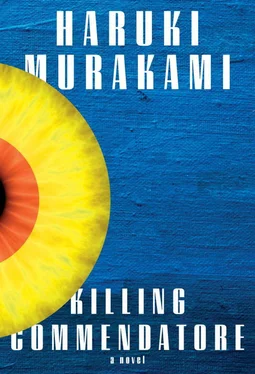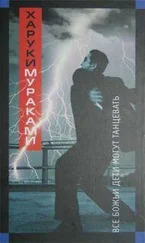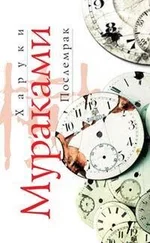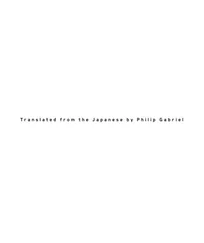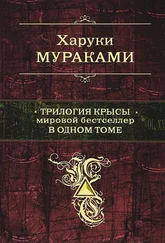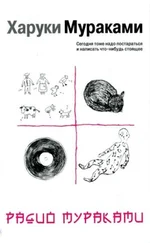The kind of paintings I did as a student, so-called abstracts, no longer appealed to me. My heart wasn’t drawn to them anymore. Looking back on it now, I see that what I’d been wrapped up in back then was nothing more than the pursuit of form. Back when I was young, I was completely drawn to the beauty of form, and to balance. Nothing wrong with that. But in my case I didn’t reach the soulful depth that should lie beyond. Now I see it very clearly, but at the time, all I could grasp was the appeal of shape at a superficial level. Nothing really moved me. My paintings were smart but nothing more.
And now I was thirty-six. Forty was just around the corner. I felt that by the time I turned forty, I’d have to secure my own unique artistic world. Forty was a sort of watershed for people. Once you get past that age, you can’t keep going on as you were before. I still had four years to go, but I knew that those four years might flash by in an instant. Painting portraits for a living had taken me on a wide detour. Somehow I had to get time on my side once again.
—
While I lived in that house in the mountains I found myself wanting to know more about Tomohiko Amada. I’d never been interested in Japanese-style painting, and though I’d heard the name Tomohiko Amada, and he happened to be my friend’s father, I had no idea what kind of person he was, or what kind of paintings he did. He might be a heavyweight in the world of Japanese painting, but he had totally stayed out of the limelight, turning his back on his worldly renown, and alone, quietly—or one might say stubbornly—focused on creating his art. This was about the extent of what I knew about him.
But as I listened to his record collection on the stereo he’d left behind, borrowed his books, slept in his bed, made meals every day in his kitchen, and used his studio, I gradually became more interested in Tomohiko Amada as a person. Something close to curiosity, you could say. The path he’d taken aroused my interest—the way he’d been focused on modernist painting, traveled all the way to Vienna to study, then after returning to Japan made a sudden return to Japanese-style painting. I didn’t know the details, but in general you would think that it couldn’t have been very easy for someone who’d done Western painting for so long to shift over to Japanese-style painting. You’d need to decide to abandon all the techniques you’d spent so much time and effort mastering, and begin again from zero. Despite this, Tomohiko Amada had chosen that arduous path. There must have been a compelling reason.
One day, before my art class, I went to the Odawara city library to search out collections of Tomohiko Amada’s artwork. Probably because he was an artist living in the area, the library had three beautiful volumes of his work. One of them included some of the Western paintings he’d done in his twenties as reference material. What surprised me was that the series of Western-style paintings he’d done as a young man reminded me somewhat of the abstract paintings I’d done myself in the past. The style wasn’t specifically the same (in the prewar period he’d been heavily influenced by Cubism), yet his stance of “greedily pursuing form” in no small way had something in common with my own approach. As you might expect from someone who went on to become a first-class artist, his paintings also had much more depth and persuasive power than mine. Technically, too, there were things about them that were, simply, astounding. I imagine they must have been highly acclaimed at the time. Still, there was something missing .
I sat there in the reading room at the library and carefully examined his works for a long time. So what was it that was lacking from his work? I couldn’t pinpoint it. But if I had to give an opinion, I’d say they were paintings that weren’t really necessary . The kind of paintings that, if they disappeared somewhere forever, wouldn’t put anybody out. A cruel way of putting it, perhaps, but it’s the truth. From the present perspective, some seventy years on, I could see that quite well.
I turned the pages and followed along, in chronological order, to see how he shifted gears to become a painter of Japanese-style art. In his early period these works were still a bit awkward, imitating the methods of previous artists, but then gradually, and undeniably, he discovered his own unique style. I could see how it progressed. A bit of trial and error at times, but no hesitation. After he took up painting Japanese-style art, his works all had something unique that only he could paint, and he himself was well aware of this. He always strode confidently toward the core of that special something . No more did you get the impression, as with his Western paintings, of something missing. It was less a shift and more akin to a conversion.
—
Like most artists of Japanese-style paintings, at first Tomohiko Amada painted realistic scenery and flowers, but eventually (and there must have been some motive for this) he began painting scenes from ancient Japan. Some were themes from the Heian and Kamakura periods, but what he was most fond of was the Asuka period at the beginning of the seventh century, specifically the period when Prince Shotoku Taishi, the legendary regent, was alive… On his canvases he boldly, minutely, reproduced the scenery, historical events, and lives of the people of that period. Naturally he had never witnessed those scenes in reality with his own eyes. But with his inner eye he saw them, clearly and vividly. Why he chose the Asuka period, I have no idea. But that became his own special period, done in an inimitable style. And with the passage of time his technique in painting Japanese-style paintings became even more refined.
If you pay close attention you can see that from a certain point on he painted exactly what he wanted to paint. From then on his brush seemed to freely leap across the canvas. The wonderful part about his paintings was the use of blank space. Paradoxically, the best part was what was not depicted. By not painting certain things he clearly accentuated what he did want to paint. This is undoubtedly one of the areas that Japanese painting excels at. At least I’d never seen such bold use of blank space in any Western paintings. Seeing this, I could somehow understand why Tomohiko Amada converted to painting Japanese art. But what I didn’t understand was exactly when and how he made that daring conversion and put it into practice.
According to his brief biography at the end of the book, he was born in the mountainous Aso district in Kumamoto. His father was a great landowner, an influential local figure, and his family was quite affluent. He was always artistically talented and distinguished himself while still quite young. He graduated from the Tokyo Fine Arts School (later Tokyo University of the Arts), and with great expectations for his career studied abroad in Vienna from the end of 1936 to 1939. At the beginning of 1939, before World War Two began, he boarded a passenger ship from Bremen and returned to Japan. Hitler was in power during this time. Austria was annexed by Germany, the so-called Anschluss taking place in March 1938. And the young Tomohiko Amada was right there in Vienna in the midst of this turbulent period. He must have witnessed a number of historical events at that time.
So what happened to him then?
I read through a long essay in one of the collections titled “Theory of Tomohiko Amada,” only to find that almost nothing was known about his time in Vienna. The essay went into great detail about his career as a painter of Japanese-style paintings after he returned to Japan, yet there was only vague, baseless speculation about the motives and details of the conversion he must have experienced during his time in Vienna. What he had done in Vienna, and what had led him to his dramatic conversion, remained a mystery.
Читать дальше
